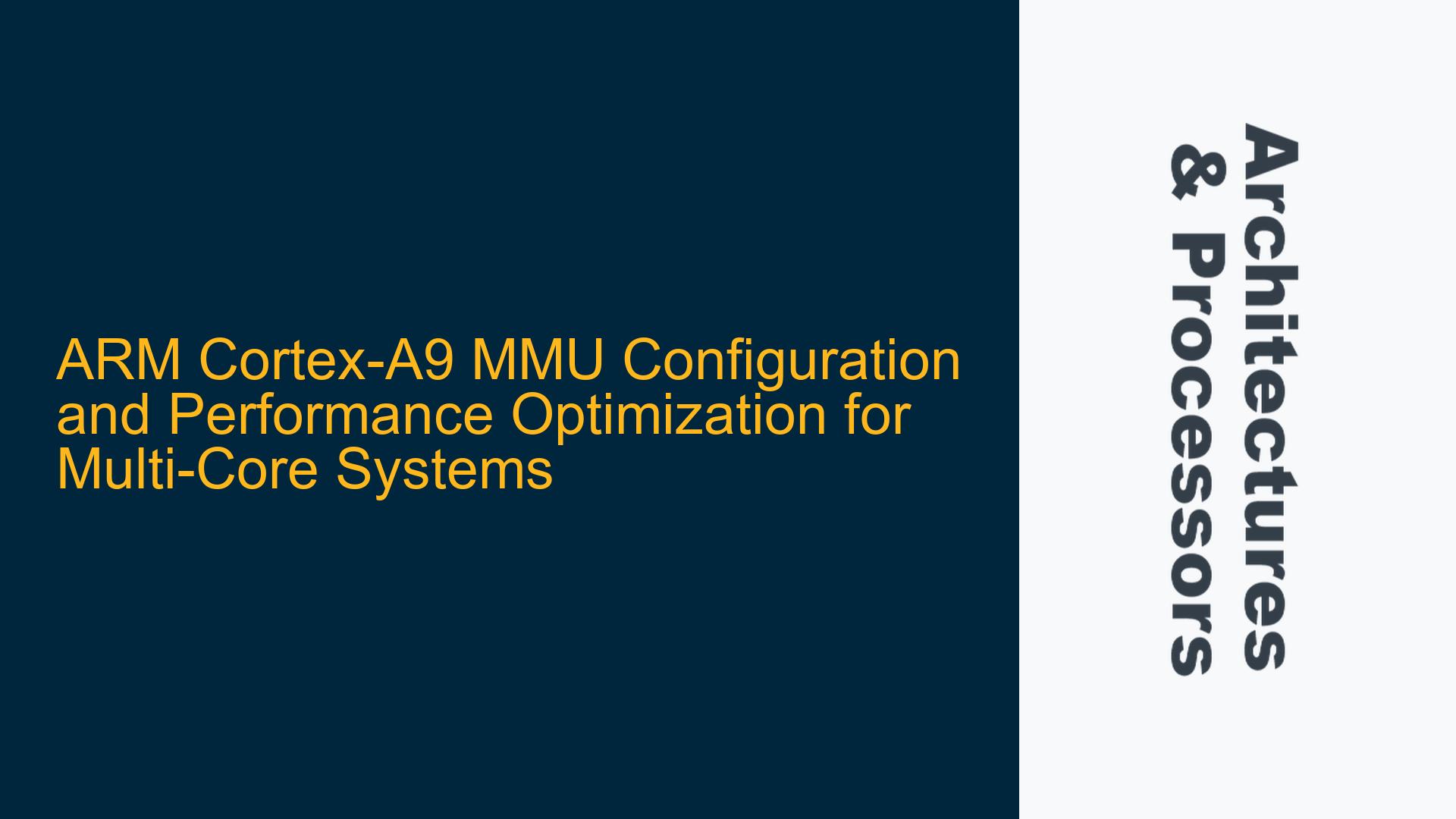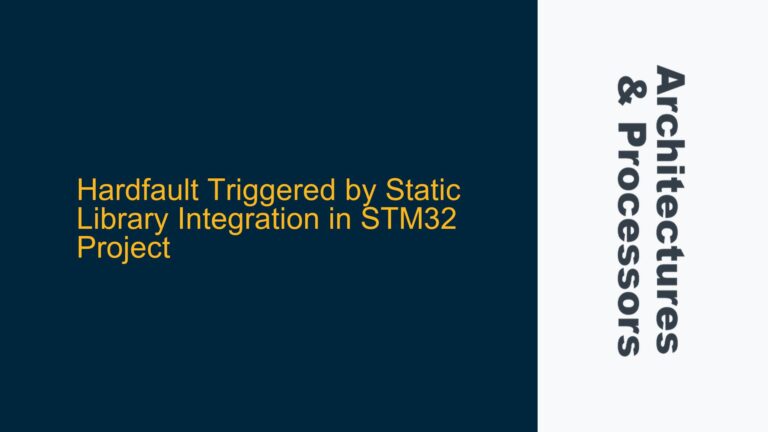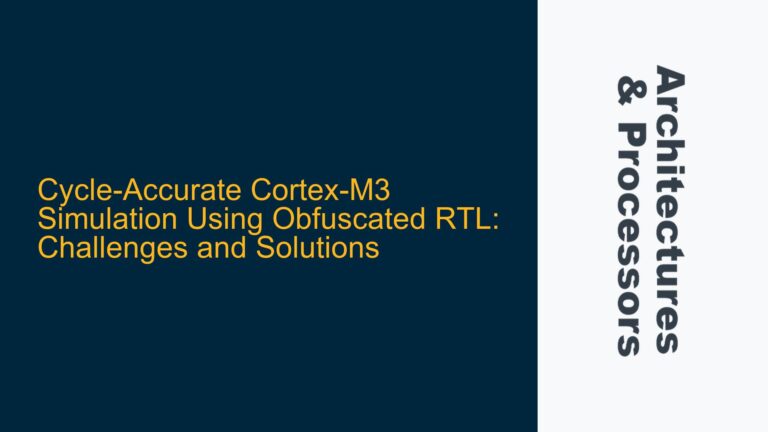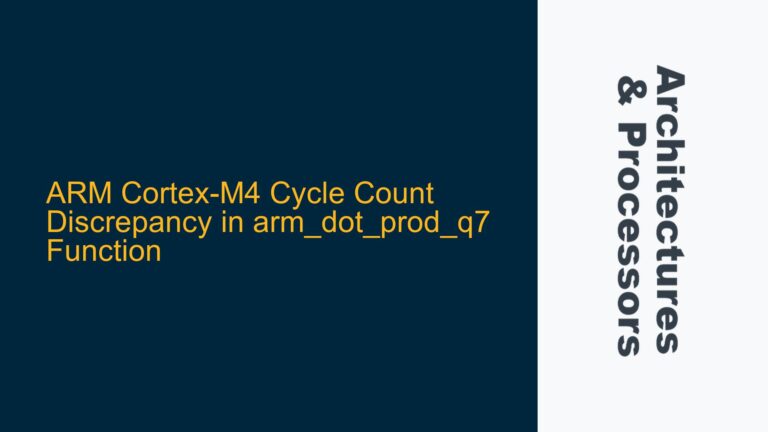ARM Cortex-A9 MMU Setup for Multi-Core Data Sharing and Cache Coherency
When working with the ARM Cortex-A9 MPcore processor, particularly in a multi-core bare-metal environment, configuring the Memory Management Unit (MMU) correctly is critical to ensure proper data sharing, cache coherency, and overall system performance. The Cortex-A9 MMU provides a flexible mechanism to define memory attributes, access permissions, and cache policies, but misconfigurations can lead to subtle bugs, performance bottlenecks, or even system crashes. In this guide, we will address the key considerations for setting up the MMU in a multi-core Cortex-A9 system, focusing on shared memory regions, cache policies, and performance optimizations.
The Cortex-A9 MMU supports multiple memory types, including Normal, Device, and Strongly Ordered memory, each with specific attributes and behaviors. When multiple cores access shared memory regions, such as in the described scenario where Core 0 reads data from a shared OCRAM region and Core 1 writes to it, the memory type and cacheability settings must be carefully chosen to ensure data consistency and optimal performance. Additionally, the Cortex-A9 provides several configuration options, such as the SMP (Symmetric Multiprocessing) bit, L1 data cache prefetch, and allocation policies, which can significantly impact system behavior.
One of the primary challenges in this setup is ensuring that the shared memory region is correctly configured to support atomic operations like LDREX/STREX, which are used to implement mutual exclusion between cores. The choice of memory type (e.g., Strongly Ordered vs. Normal) and cacheability settings (e.g., Write-Back vs. Write-Through) must align with the hardware’s capabilities and the application’s requirements. Furthermore, the Cortex-A9’s cache coherency mechanisms, such as the snoop control unit (SCU), must be properly utilized to maintain consistency across cores.
SMP Bit Configuration, Cache Prefetch, and Allocation Policies
The Cortex-A9 MMU provides several configuration bits that influence system behavior, particularly in multi-core environments. The SMP bit, which stands for Symmetric Multiprocessing, is one such configuration that determines how the processor handles cache coherency and memory barriers. When the SMP bit is set, the Cortex-A9 assumes that it is operating in a multi-core environment and enforces stricter cache coherency rules. This is essential when multiple cores access shared memory regions, as it ensures that updates to memory are visible to all cores in a timely manner. Even if the cores do not directly interact, setting the SMP bit is generally recommended to avoid potential coherency issues.
The FW (Force Write) bit is another configuration that can be set in conjunction with the SMP bit. The FW bit forces write-through behavior for shared translation tables, ensuring that updates to the tables are immediately visible to all cores. This is particularly important when the cores share translation tables, as it prevents inconsistencies that could arise from cached updates. However, enabling the FW bit can introduce additional overhead, as it bypasses the cache for translation table updates. Therefore, it should only be set when necessary, such as when shared translation tables are used.
The L1 data cache prefetch bit is a performance optimization that allows the Cortex-A9 to prefetch data into the cache before it is explicitly requested by the processor. This can improve performance for workloads with predictable memory access patterns, such as streaming data or large memory copies. However, prefetching can also increase cache pollution, particularly if the prefetched data is not actually used. In the described scenario, where Core 0 performs large frame buffer copies, enabling the L1 data cache prefetch bit may improve performance, but it should be carefully evaluated to ensure that it does not negatively impact other workloads.
The "Alloc in one way" bit is another configuration that can influence cache behavior. When enabled, this bit restricts cache allocation to a single way, reducing cache contention and potentially improving performance for specific workloads. For example, during large memory copies, enabling this bit can prevent cache thrashing by ensuring that the copied data does not evict other useful data from the cache. However, this configuration should be used judiciously, as it can reduce the effective cache size and may not be beneficial for all workloads.
Memory Type Selection, Cache Policies, and Performance Trade-offs
The Cortex-A9 MMU supports several memory types, including Normal, Device, and Strongly Ordered memory, each with specific attributes and behaviors. Normal memory is used for general-purpose data and code storage and supports caching and write-back or write-through policies. Device memory is used for memory-mapped peripherals and supports specific access ordering requirements. Strongly Ordered memory is used for regions where access ordering must be strictly enforced, such as shared memory regions accessed by multiple cores.
In the described scenario, the shared OCRAM region is configured as Strongly Ordered memory to ensure that updates from Core 1 are immediately visible to Core 0. This is a valid configuration, as Strongly Ordered memory enforces strict access ordering and prevents caching, which is essential for maintaining data consistency in multi-core systems. However, it is important to note that Strongly Ordered memory does not inherently imply any specific access permissions (e.g., Read-Only or Read-Write). These permissions must be explicitly set in the MMU translation tables.
For DRAM memory, the choice between Write-Back and Write-Through caching policies can significantly impact performance. Write-Back caching allows the processor to defer writes to memory, reducing memory bandwidth usage and improving performance for write-intensive workloads. However, it also introduces the risk of data inconsistency if the cache is not properly managed. Write-Through caching, on the other hand, ensures that all writes are immediately propagated to memory, simplifying cache management but potentially reducing performance. In the Cortex-A9, Write-Through caching is not fully supported, and enabling it may result in non-cacheable behavior. Therefore, Write-Back caching is generally recommended for DRAM memory.
The frame buffer memory, which is used for displaying data on the LCD, is an example of a memory region where caching may not be beneficial. Frame buffers are typically written once and read many times by the display controller, and caching can introduce unnecessary overhead. In this case, configuring the frame buffer memory as non-cacheable can improve performance by reducing cache pollution and ensuring that the display controller has direct access to the most up-to-date data.
Finally, the TEX (Type Extension), C (Cacheable), and B (Bufferable) bits in the MMU translation tables provide fine-grained control over memory attributes and cache policies. These bits can be combined to create custom memory types, such as Write-Back Write-Allocate (WBWA), which is used in the SDK for the described processor. The WBWA configuration (TEX: 001, C: 1, B: 1) is a valid memory type that combines Write-Back caching with Write-Allocate behavior, ensuring that cache lines are allocated on writes. This configuration is not explicitly listed in the Cortex-A Series Programmer’s Guide but is supported by the Cortex-A9 and can be used to optimize performance for specific workloads.
In conclusion, configuring the Cortex-A9 MMU for multi-core systems requires careful consideration of memory types, cache policies, and performance trade-offs. By understanding the implications of each configuration option and aligning them with the application’s requirements, developers can ensure optimal performance and data consistency in their systems.






